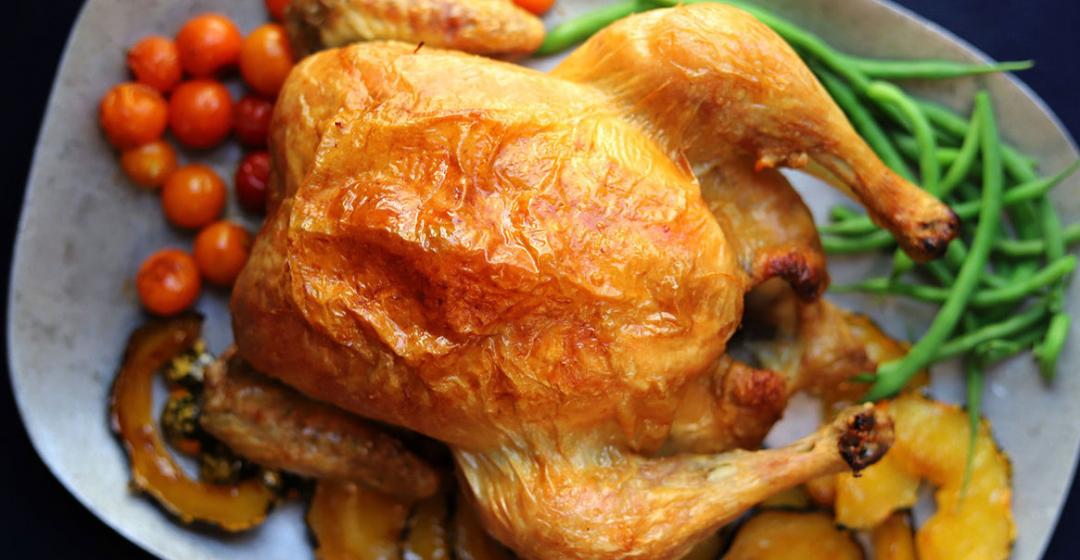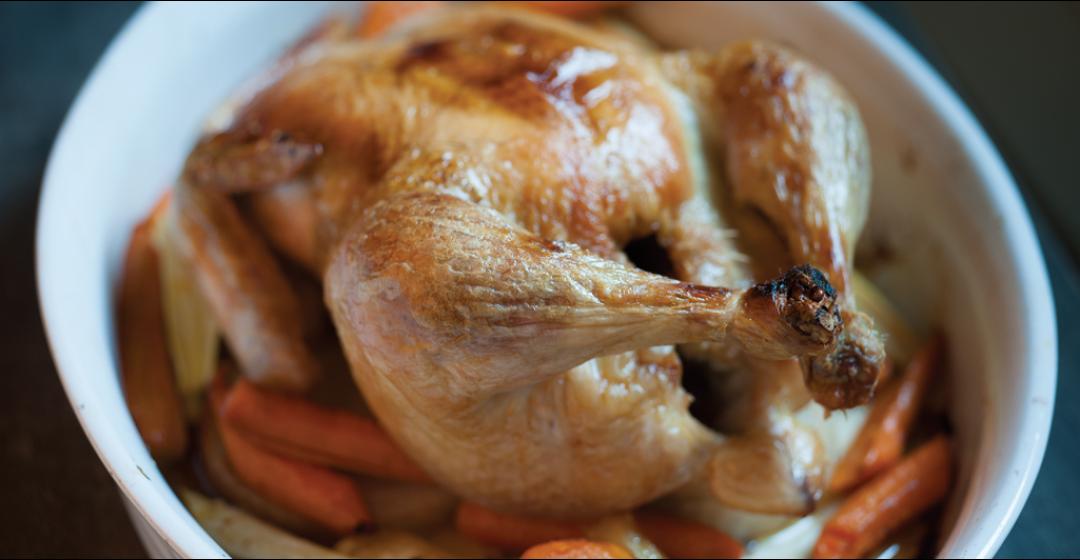Inspired by cookbook author Susie Middleton of West Tisbury, who starts her chicken breast-side down on a roasting rack before turning it over, I came up with this recipe that combines my favorite salting technique with Susie’s cooking method at a high heat. These recipes originally appeared with the article There's More Than One Way to Roast a Chicken.
Serves 4
- 1 whole chicken, 3 1/2–4 1/2 pounds
- 2–3 teaspoons kosher salt
- Black pepper, to taste
- Olive oil or butter to rub on chicken
- Pan Gravy or Lemon-Herb Sauce (see below, optional)
1. The night before you want to roast your chicken, arrange it, uncovered, on a rack over a shallow baking dish. Rub it all over with the salt and refrigerate (uncovered.)
2. Remove the chicken from the fridge 30 to 45 minutes before cooking. Heat the oven to 425 degrees. Rub the chicken with a little olive oil or softened butter, season with pepper, and arrange back in the roasting rack (in the pan), breast side-down. Roast for 30 minutes.
3. Turn the chicken over and roast for an additional 25 to 30 minutes (it will have marks from the rack, but those will disappear).
4. After 55 to 60 minutes total, insert a thermometer into the thigh (without touching a bone). When thermometer reads about 170 degrees, the meat is cooked. Remove bird from oven. If making gravy or sauce, don't transfer the chicken to a carving board without reading directions below.
Pan Gravy
This gravy uses the defatted chicken juices and any bits left in the roasting pan after roasting the chicken. Before removing the chicken from the roasting pan, tilt the chicken and let any juices inside the bird flow into the pan. If you strain the fat, it’s healthier and you don’t sacrifice any flavor, which is in the juices and the brown bits at the bottom of the pan. A fat separator is not essential, but if you like to make gravy, it is an inexpensive tool that lets you easily pour off fat and keep the chicken juices – and it’s quicker and easier than using a spoon.
- 2 tablespoons butter
- 2 tablespoons flour
- Chicken pan drippings, or defatted chicken liquid
- 1–2 cups chicken stock
- Salt, to taste
1. Place roasting pan on stove (if it can go on burner), add butter, and melt over medium-low heat. Add flour and whisk together. Add defatted pan juices and about 1 cup stock, whisking to incorporate flour-butter mixture and any brown bits left on the bottom of the pan.
3. Bring to a boil over high heat, whisking occasionally. When it boils and begins to thicken, add more chicken stock if needed to achieve desired consistency. Taste before adding salt, then season. Turn to medium-low heat till ready to serve, whisking occasionally.
Lemon-Herb Sauce
Tarragon and chicken go together nicely, and you can make the sauce while the chicken is resting after roasting.
Serves 4 to 6
- 2 tablespoons butter
- 1 1/2 teaspoons finely minced shallot
- 1 tablespoon flour
- Chicken pan drippings, or defatted chicken liquid
- 1/2–1 cup chicken stock
- 1 teaspoon minced fresh parsley leaves
- 1 teaspoon chopped fresh tarragon leaves
- 2 teaspoons fresh lemon juice
- 1/4 teaspoon salt, if needed
- 1/4 teaspoon ground black pepper
1. In a medium skillet on medium-low heat, add the butter and shallot and cook 2 to 3 minutes until shallot begins to brown. Add flour and mix in well. Whisk in any pan juices (minus the fat) and brown bits scraped from the chicken pan. Add 1/2 cup chicken stock to start, and bring the whole mixture to a boil. Depending on the amount of pan juices, add additional stock to reach desired consistency.
2. Mix in the parsley, tarragon, and lemon juice. Taste the sauce and season with salt and pepper. Serve hot.




 2 comments
2 comments



Comments (2)